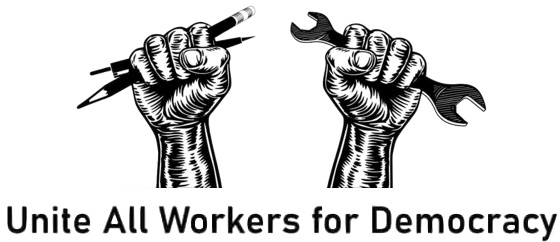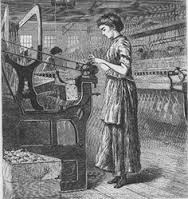Follow Erik Loomis on Twitter
Read Erik Loomis on Lawyers, Guns, & Money
Historian Erik Loomis on This Day in Labor History: September 15, 1845. Women working in the Pittsburgh textile mills met in Market Square to discuss the necessity of fighting to cut their days from 12 to 10 hours without a reduction in pay. Let’s talk about this early moment of American labor militancy.
As the textile industry expanded by the 1840s, the earlier visionary leadership to create a humane factory system at Lowell had been resoundingly defeated by capital in a competitive industry with low-capitalization and plentiful workers.
That industry was rapidly expanding as well. Originally focused in New England, by the 1830s, it was a major employer in New Jersey, where women struck for better conditions. And by the 1840s, it had spread west. Pittsburgh had become an important center of textile production.
About 5,000 workers labored in these mills. Like the rest of the textile industry, most of them were women and children, working in tremendously unsafe conditions for low wages.
They worked 72 hour weeks, 12 hours a day, six days a week. Women made between $2.50 and $6 a week. Children topped out at $3 a week.
As competition came to define this industry, employers sought to take profit out of workers’ already meager wages. In 1843, this hit Pittsburgh and workers wages were slashed. This led to the first confrontation in a workers’ movement that culminated two years later.
In 1845, 5,000 workers in Pittsburgh and nearby Allegheny City walked off their job. They had simple demands–a wage increase that would return them to what was passing for a livable wage before the 1843 cuts, as well as the ten-hour work day.
On September 15, at the mass meeting, the workers decided to “turn out” until they received their 10 hour day. They sought solicitations from other workers in the Pittsburgh area.
Employers said no way, claiming it would make them noncompetitive with New England mills. The strike was on.
This was not a well-organized strike. There was no union and certainly no sort of strike pay, except whatever pennies workers around the city donated. It was an act of desperation.
They held on for about a month, which is pretty remarkable considering the dire straits of their lives. They knew that if they had any chance to win, they would have to keep scabs out of the mills.
Some women decided to use force to make that happen. Taking axes with them, they stormed factory doors to drive away the scabs and the hired guards. It sometimes worked.
But the American public throughout the 19th century — and really through the vast majority of American history — really abhorred the idea of workers organizing.
Because we tell stories of workers’ heroic struggles against employers in our memory of labor history, we leave out the general public. And the general public repeatedly turned harshly against even mild levels of worker organizing.
Sure, some of that was driven by employer-dominated media, but it also related to deep seated ideas of individualism and Jefferson agrarianism in American mythology that saw cities themselves as evil — partially because they spawned dirty factories, poverty, and unions.
Such was the case for the textile strike in Pittsburgh. At first, there was support for the workers in the local newspapers, who noted that 12 hours was too long for workers to labor. But this would be short-lived.
Soon, popular support was firmly on the side of the employers, more so as time went on. They struck back too, having their hired goons beat the women and children fighting for a better life.
Given that the strikers were starting to break machines and burn company gates, this reaction probably isn’t too surprising.
In the Blackstock Mill, scabs were operating the machines. The women leading the strike had made common cause with the nascent union movement in Pittsburgh — the beginnings of one of the nation’s strongest union towns.
Together, on October 6, 1845, they decided to march on the Blackstock and evict the scabs working inside. The women did all the dirty work. They broke down the factory gates, marched inside, physically grabbed the workers, and threw them out of the mill.
The male unionists stood as their guard against the police and the company’s muscle. This was a brief victory, but also only exacerbated the public feeling against the workers.
Whatever feeling there was for the workers disappeared nearly overnight and the newspapers began calling for the end of the strike on October 7. Ultimately, for Americans, private property mattered more than workers’ rights.
Even supporters of the strike began to worry that the strikers were overturning the “harmony” between capital and labor that supposedly was the atmosphere in Pittsburgh.
You see these displays again and again in the 19th century, with many Americans ultimately believing fervently in the growing system of industrial capitalism and blaming workers when they took action against it.
In the New York Tribune, the famed journalist Horace Greeley began calling the women “The Amazons of Allegheny.” The strike soon collapsed and the women and children gained nothing. By October 20, the mills were all running once again on the 12 hour work day.
The strike did tap into larger reform efforts throughout the northeast that hoped to alleviate some of the worst exploitation in the mills. In 1848, this led the Pennsylvania legislature to pass a law that prohibited employers from employing workers for more than 10 hours a day.
However, in an era where both the idea of the contract was a god and the state found the idea of regulation repellent, employers soon pushed through a follow-up bill that allowed exceptions to the new 10-hour law if an employee signed a contract agreeing to the longer day.
Of course that immediately eviscerated the 10-hour law. All workers had to sign those contracts and the spirit of the law was destroyed. The workers of Pennsylvania and the United States would have to wait another 90 years for the law to require reasonable working hours.
Ultimately, the problem of wages and hours could not be handled locally in a mobile industry.
Even had Pennsylvania vigorously enforced the 10-hour law, in an industry like textiles, the competition from New England mills and the constant look for new production sites meant it would have been very hard for the Pittsburgh mills to remain competitive.
Like today, meaningful labor reform would require federal action that was not coming in 1845. Or in 2020.
This thread borrowed from Jason Martinek’s article “The Amazons of Allegheny: The Fire, the Riot, and the Textile Strike of 1845,” in the Spring 2011 issue of Western Pennsylvania History.

